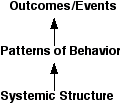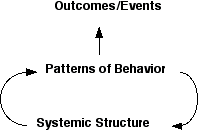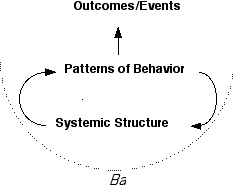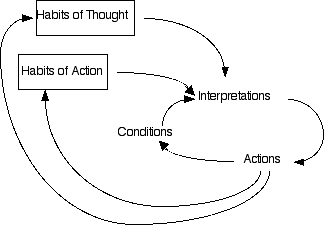Peter Senge Comments on | |||||||||||||||||||||||||||||||
| Section: Change Management | |
|
Author(s): Peter Senge, Dialog on Leadership |
Posted: March 31, 2004 Hits: 14360 |
|
||||
|
1. What is the essential insight in this material for me (how would I explain it from a theoretical perspective, or in terms of key underlying ideas)?
The essential insight for me is that we are getting closer to understanding the generative territory at the heart of all leadership. There are many definitions of leadership, but a common element concerns the capacity to sustain change that brings forth new realities in line with people’s genuine aspirations. Understanding how this happens has eluded most contemporary leadership theories in my judgement. For me, the best way to explain what is emerging in this project is in the context of my own training and background in the dynamics of complex social systems. Traditionally, the system dynamics method (Forrester, Sterman) has been based on a positivistic epistemology focused on the way that the structure of feedback relationships in a social system influences the patterns of behavior that system can generate. For example, according to this view, growth can only arise if there are underlying reinforcing feedback processes whereby movement in one direction (like increased sales) creates subsequent changes (like increased revenues re-invested in new products) that create still further movement in the same direction. Or, oscillations arise due to delays in balancing processes (like those involved in restocking an inventory in a complex supply chain) or due to multiple mutually inconsistent goals (like goals to decentralize to foster innovation and centralize to foster control). In turn the results or outcomes achieved in a system are a consequence of these patterns of behavior. In particular, the events that often capture management attention arise when these patterns of behavior produce sudden or unanticipated changes that are undesirable, like sales shortfalls or out-of stock inventories. This traditional system dynamics view of causality is summarized in the figure below:
 But system dynamics has had little to say about where particular feedback structures come from, or why some structures dominate and not others. Without an account of the coming into being of the feedback structures that give rise to persisting patterns of behavior, system dynamics lacks a compelling theory of practice that can inform leaders interested in creating new structures, behaviors and outcomes. (The default theory of practice in system dynamics has been technocratic: experts figure out how a system works, then explain this to managers, who then "change the system’s policies" or other features to create new structures and new behaviors. This presumes that managers’ have the capabilities to effect such changes, which is at best true for formal structures not the informal "operating policies" that typically govern actions.) By contrast, Giddens’ structuration theory or Weick’s theory of enactment says that social structures are continually being created through people’s daily actions. From their vantage point, humans are continually creating structures — patterns of interdependency — whether they are aware of it or not. For example, past behavior shapes norms and expectations, which then govern future behavior; past practices of goal setting and weighing some information more than others in setting production schedules shapes current operating production policies. According to this view, structures, rather than being fixed, are relatively "frozen" for the moment. But they are also in continual flux, continually being reestablished or changed by the actors in a system. There is no presumption that all actors have equal capabilities to enact new structures. For example, postions of authority confer on some the abilities to declare changes in formal rules or reorganize formal work arrangements. But, whether such changes in formal structures give rise to changes in operating or informal structures depends on the actions of many people. For example, often times, senior managers declare changes that are summarily ignored by local managers. In this way, the structuration or enactment view fits naturally with seeing leadership as a distributed phenomenon. That is, many must act differently for larger systems to change. There may be differential abilities among different actors to influence, but there is little unilateral influence. The problem with structuration or enactment is that it explains little about the dynamic consequences of different enacted structures — that is, the different patterns of behavior that arise from different structures. Combining the system dynamics and enactment views leads to what Wanda Orlikowski and I call the enacted systems view, expressed in the following diagram:
 The theory of enacted systems suggests a continual interaction among structure and behavior: structures are continually being shaped by people’s current actions, and these structures in turn shape future actions. We create the structure and then the structure creates us. I believe that this enacted systems view takes a step in laying a rigorous foundation for starting to see how leadership as a distributed phenomenon can bring about deep changes in structure and behavior, or fail to do so. It deals with social reality on three interdependent levels: events or outcomes, patterns of behavior over time, and underlying structures which both give rise to those patterns and are continually shaped by them. From this view, leadership is about enacting new structures, which in turn give rise to new patterns of behavior and new outcomes. The McKinsey/SoL study extends this view by addressing the possible sources of such leadership, that is the conditions for enabling the interdependent unfolding of new structures and behaviors. In particular, it suggests that the place from which actions arise matters. Rather than being only driven from existing structures (such as habits of thought and habits of action — see Appendix), actions can also arise from deeper levels. The study develops two complementary views on these deeper levels: one that emphasizes individual cultivation and one that suggests collective cultivation. For Varela and Rosch, new actions capable of creating new structures can arise from becoming aware (Varela) and from primary knowing (Rosch). For Varela, the fragile or virtual self is transcended through the discipline of experience, through developing the capacity to pay much closer attention to the phenomena we live through — specifically through the interplay of suspension, redirection, and letting go. For Rosch, "follwing your nature far enough… (until) you find the original way of being," can lead to a different source of action, acting "without conscious control — even without the sense of me doing it." Such a shift in the experience of self when acting in more authentic or original ways has roots in many traditional ideas of transcendent action. Csikszentmihalyi discovered striking similarities across many experiences of optimal or peak performance, in the arts, sports, and other domains. People consistently report of "losing oneself," of "watching what I am doing without thinking about it." He points out that the Greek root of "ecstasy" literally means "standing to the side." In his book, To Realize Enlightenment, Master Nan Huai-Chin quotes the Yogacarabhumi shastra on stages of development that are not samadhi (the first stage of enlightenment), "Because they lack ease and peace, and still contain and nourish and develop the seeds of karma, these states are not called samadhi. (my emphasis)." So, acting in such authentic or original ways neither arises from past habit nor engrains future habit. Rather, it allows something new to arise. Could this be one source of evolving new structures? Nonaka adds to this emphasis on individual cultivation the idea that importance of a shared context or ba. Nishida’s three dimensions of ba — physical, inter-subjective, and trans-subjective — suggest that the capacity to create a generative ba depends at least in part on capacity for transcending normal experiences of self. Or, to put it another way, the capacity to nurture a generative ba hinges on the interdependent capacities to attend to the physical, inter-subjective, and self-transcendent dimensions. All are linked. None can be nurtured independent of the others. So, in this sense, there is no collective cultivation without individual cultivation. Perhaps the reverse is true as well? Jaworski’s and Sheldrake’s evocation of fields suggest that aspects of generative ba are energetic, akin to quantum or electromagnetic fields that create "causality at a distance." When individuals act out of their primary knowing they become part of larger forces that can shape structures and behaviors, "a force of nature," as George Bernard Shaw put it, beyond themselves. The person who is "turning," to use Buber’s (I and Thou) term, toward a more authentic source of experience, "tears to pieces the web of habitual instincts, and stirs rejuvenates, and transforms the stable structures of history." Bohm characterized this as the "unfolding of the implicate into the explicate," which he regarded as the generative process of the universe. Generative shared contexts or fields arise out of authentic actions informed by a larger flow of meaning. Moreover, acting out of such a state of being not only connects people to nature’s unfolding but to one another. The generative field is both deeply personal and inherently collective. Putting all these ideas together gives a multidimensional picture of reality generation on four levels: events or outcomes, patterns of behavior, structures (patterns of interdependencies), and field or ba:
 This suggests that leadership attention must operate at all four levels, although the greatest leverage will usually lie in the deepest levels. It does not imply, to me, that attention should only focus at the level of field or ba. For example, one way to validate shifts in underlying fields is to look at shifts in underlying structures and patterns of thought and action that they shape and in turn respond to. Likewise, leadership is ultimately about results people are able to produce. The territory of leadership in the service of bringing forth new realities requires capabilities to attend to all four levels. The challenges this creates are immense and probably go a long way to explaining why such leadership is rare. This will remain the case so long as cultivation of people’s capacities to attend to all levels remains neglected. 2. How would I explain this to practitioners? It is time now to return to some of the oldest ideas about leadership. For thousands of years, people have regarded the capacity to lead as inseparable from the personal maturity or cultivation of those in leadership positions. In western culture we had the "philosopher king;" in Chinese culture the Confucian theories of leadership development. By and large, these ideas have been lost in modern times. People now rise to positions of authority in business, government, and other large institutions based on their intelligence, articulateness, and often their skills in political gamesmanship. They then find themselves in positions where their skillset does not match the requirements of the job. They are conditioned to be advocates yet what is required is collaborative inquiry. They are problem solvers yet what is required is framing complex dilemmas and understanding short- versus long term trade-offs. They are good at delivering to a plan yet now face complex emergent realities that are forming as they act and require attending to the moment and the willingness to abandon plans and to improvise. They are good at commanding yet they must now lead through moral suasion. I believe that practical realities will compel more and more organizations to learn what it takes to create a climate that encourages cultivation and continual deep learning, especially for those who rise to positions of authority. They will be compelled by complex, dynamic market realities, which require harnessing intelligence and imagination at all levels. They will be compelled by competitive labor markets and the increasing range of opportunities available to "free agent" members. They will be compelled by customers who are becoming increasingly proactive in expressing their desires. Organizations must also learn to understand the diverse ways and positions from which people can lead. If people are really enabled to grow in authentic ways, they will develop their natural capacities to lead regardless of their formal positions. But they will also become more diverse not less so. Traditional forces for homogenization of leaders, for creating the "old boy networks" that still dominate many large organizations, will be increasingly at odds with growing diversity. Effecting such changes will require new tools and approaches to leadership cultivation. Training and formal education will play a role. But, like all deep learning, the most important developmental processes will be rooted in the context of addressing real goals and practical problems. This will require mentoring. But it also will require enacting work environments that combine inquiry and reflection with decision taking. This will involve innovations in infrastructure like managerial practice fields and learning laboratories. It will also require attending in more subtle ways to the overall environment or context within which work occurs. People know when they are in a "generative space." They sense the excitement, trust, and openness to new ideas combined with commitment to results. Few experiences shape people’s leadership capacities more than being part of an extraordinary team that achieves the impossible. I believe that organizations that will thrive in the current economic reality will increasingly learn how to collectively cultivate the capacity to create such spaces. This requires but also goes beyond individual cultivation. Lastly, If indeed there come to be more authentic leaders at all levels, organizations will rejoin an old battle with renewed vigor, between the drive for merit and the drive for personal power. The ethical foundations of organizations, especially corporations, will be increasingly challenged. They will be challenged externally from greater demands for environmental and social accountability. But they will also be challenged internally, to the extent that latent desires are unleashed for spiritual growth by their members. 3. What strikes me personally about this material? I have been especially struck by the depth of personal reflection and disclosure in many of the interviews. In these intimate glimpses into the lives of many leading scientists, I have been very surprised to see how many have deep personal commitments to disciplines for their own cultivation. Moreover, their personal work is inseparable from their science, both the process and the substance of their science. I cannot but believe that this is a new development of potentially great importance. Many have noted that science is the religion of this day. Scientists occupy a position of respectability and deference, whether rightly or wrongly, not unlike the position accorded to religious leaders in other eras. They represent society’s quest for truth. They are typically seen as having a degree of professional integrity, , unlike business or public leaders, that places precepts like honesty and fairness above personal gain. Yet the mainstream western scientific epistemology has, for several hundreds of years, fragmented the scientist’s insights from who they were as a person. Objectivity has come to mean producing declarative statements about the world independent of the observer. While some of these cornerstone ideas about the separation of observation and observer began to break down in the early 20th century physics, the mainstream scientific worldview, the way science is taught to children, and the core professional practices were not affected by this. Yet many of the people in these interviews, leading scientists, are living and articulating a very different view of interconnection between personal cultivation and scientific inquiry. They are seeking a new synthesis, such has precedents in the west, like Goethe, but has always been relegated to an outlier. I believe the underlying intent behind western science has always been to dominate and control. What might be the new intent emerging behind a new synthesis of science and spirituality? Might it lead to new orientation and ultimately new capabilities in shaping social realities? APPENDIX — Theory of Enacted Systems Wanda Orlikowski and I have been teaching a pilot course for the past two years that integrates the system dynamics and enactment/structuration views of causality in social systems. The basic unit of analysis for social reality formation in this class is shown below. All human actions arise in the midst of a continuous interaction of interpreting, acting, and influencing conditions, which then give rise to new interpretations and actions. But these interpretations are also shaped by mental models, habits of thought and action, which themselves are embedded in feedback loops influenced by current actions and conditions:
 System dynamics and enactment or structuration naturally complement one another. Just as enactment addresses the blind spot in system dynamics around how structures come into being, so does system dynamics address the blind spot in the enactment view about how different structures have different dynamic consequences, that is give rise to different patterns of behavior over time. |
| COMMENTS |
| NUMAN, istilltanha@hotmail.com Sir: please tell me the sides of management i.e 1.basic management 2.modren management 3.Planning management 4.organizing management 5.Staffing management 6.leading management 7.conttroling management 11 19:19:26.11.2004 Reply |
|
METHODOLOGY: Strategy, Marketing, Changes, Finance, HRM, Качество, IT TOPICS: News, Events, Trends, Insights, Interviews, Business Learning, Book Reviews, Consulting SERVICES: Business Books, Job, Forums, Glossary, Citations, Ranks PROJECTS: Blog, Business Video, Vision, Visionary, Business Prose, Business Humor Copyright © 2001-2025, Management.com.ua |
 Author and educator Peter M. Senge (MIT Sloan School of Management) comments on the dialogue-interviews in
Author and educator Peter M. Senge (MIT Sloan School of Management) comments on the dialogue-interviews in